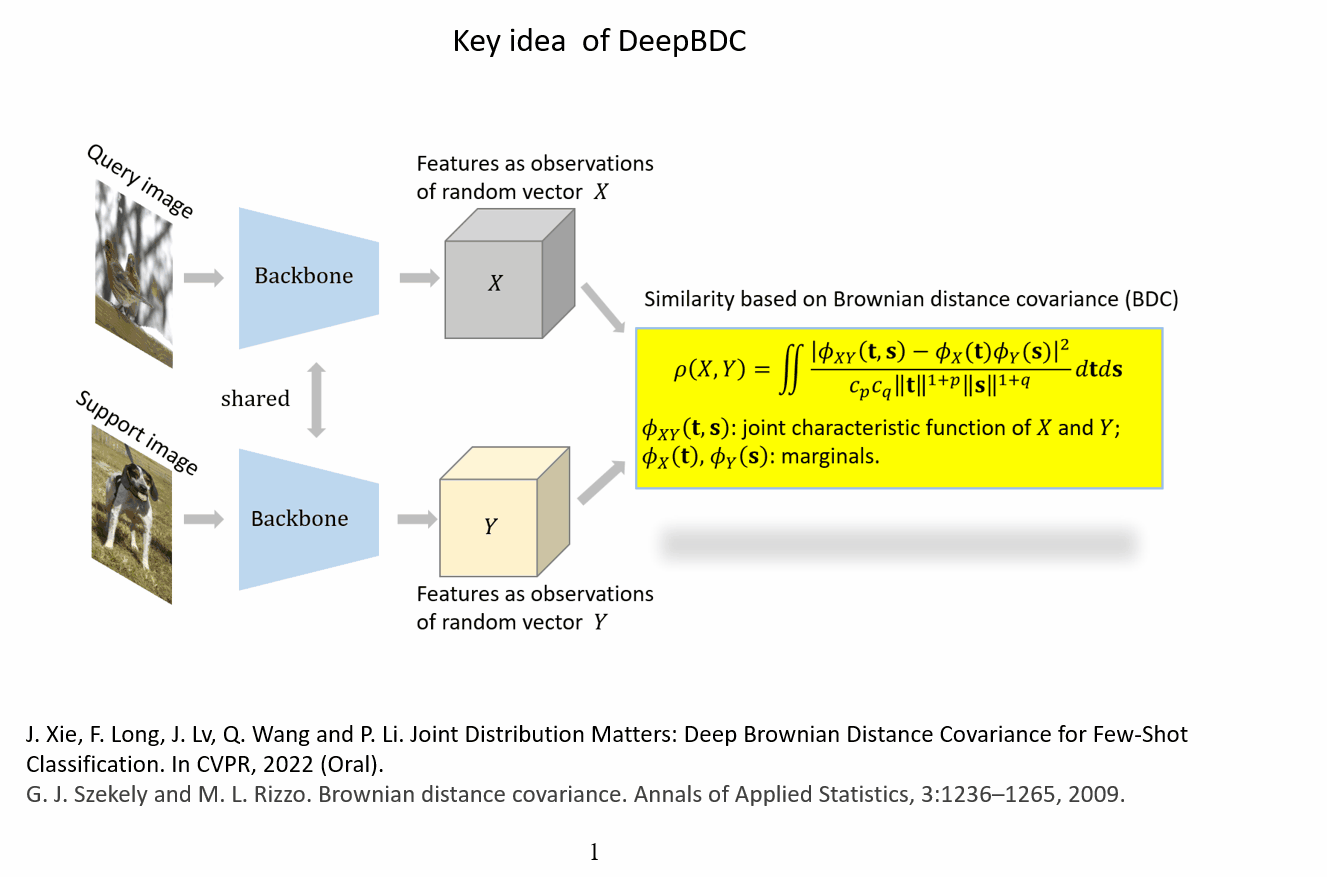DeepBDC for few-shot learning
Introduction
In this repo, we provide the implementation of the following paper:
"Joint Distribution Matters: Deep Brownian Distance Covariance for Few-Shot Classification" [Project] [Paper].
In this paper, we propose deep Brownian Distance Covariance (DeepBDC) for few-shot classification. DeepBDC can effectively learn image representations by measuring, for the query and support images, the discrepancy between the joint distribution of their embedded features and product of the marginals. The core of DeepBDC is formulated as a modular and efficient layer, which can be flexibly inserted into deep networks, suitable not only for meta-learning framework based on episodic training, but also for the simple transfer learning (STL) framework of pretraining plus linear classifier.
If you find this repo helpful for your research, please consider citing our paper:
@inproceedings{DeepBDC-CVPR2022,
title={Joint Distribution Matters: Deep Brownian Distance Covariance for Few-Shot Classification},
author={Jiangtao Xie and Fei Long and Jiaming Lv and Qilong Wang and Peihua Li},
booktitle={CVPR},
year={2022}
}
Few-shot classification Results
Experimental results on miniImageNet and CUB. We report average results with 2,000 randomly sampled episodes for both 1-shot and 5-shot evaluation. More details on the experiments can be seen in the paper.
miniImageNet
| Method | ResNet-12 | Pre-trained models | Meta-trained models | |||
|---|---|---|---|---|---|---|
| 5-way-1-shot | 5-way-5-shot | GoogleDrive | BaiduCloud | GoogleDrive | BaiduCloud | |
| ProtoNet | 62.11±0.44 | 80.77±0.30 | Download | Download | Download | Download |
| Good-Embed | 64.98±0.44 | 82.10±0.30 | Download | Download | N/A | |
| Meta DeepBDC | 67.34±0.43 | 84.46±0.28 | Download | Download | Download | Download |
| STL DeepBDC | 67.83±0.43 | 85.45±0.29 | Download | Download | N/A | |
Note that for Good-Embed and STL DeepBDC, a sequential self-distillation technique is used to obtain the pre-trained models; See the paper of Good-Embed for details.
CUB
| Method | ResNet-18 | Pre-trained models | Meta-trained models | |||
|---|---|---|---|---|---|---|
| 5-way-1-shot | 5-way-5-shot | GoogleDrive | BaiduCloud | GoogleDrive | BaiduCloud | |
| ProtoNet | 80.90±0.43 | 89.81±0.23 | Download | Download | Download | Download |
| Good-Embed | 77.92±0.46 | 89.94±0.26 | Download | Download | N/A | |
| Meta DeepBDC | 83.55±0.40 | 93.82±0.17 | Download | Download | Download | Download |
| STL DeepBDC | 84.01±0.42 | 94.02±0.24 | Download | Download | N/A | |
Note that for Good-Embed and STL DeepBDC, a sequential self-distillation technique is used to obtain the pre-trained models; See the paper of Good-Embed for details.
References
[BDC] G. J. Szekely and M. L. Rizzo. Brownian distance covariance. Annals of Applied Statistics, 3:1236–1265, 2009.
[ProtoNet] Jake Snell, Kevin Swersky, and Richard Zemel. Prototypical networks for few-shot learning. In NIPS, 2017.
[Good-Embed] Y. Tian, Y. Wang, D. Krishnan, J. B. Tenenbaum, and P. Isola. Rethinking few-shot image classification: a good embedding is all you need? In ECCV, 2020.
Implementation details
Datasets
- miniImageNet: We use the splits provided by Chen et al.
- CUB: We use the splits provided by Chen et al.
- tieredImageNet
- Aircraft
- Cars
Implementation environment
Note that the test accuracy may slightly vary with different Pytorch/CUDA versions, GPUs, etc.
- Linux
- Python 3.8.3
- torch 1.7.1
- GPU (RTX3090) + CUDA11.0 CuDNN
- sklearn1.0.1, pillow8.0.0, numpy1.19.2
Installation
- Clone this repo:
git clone https://github.com/Fei-Long121/DeepBDC.git
cd DeepBDC
For Meta DeepBDC on general object recognition
cd scripts/mini_magenet/run_meta_deepbdc- modify the dataset path in
run_pretrain.sh,run_metatrain.shandrun_test.sh bash run.sh
For STL DeepBDC on general object recognition
cd scripts/mini_imagenet/run_stl_deepbdc- modify the dataset path in
run_pretrain.sh,run_distillation.shandrun_test.sh bash run.sh
Acknowledgments
Our code builds upon the the following code publicly available:
Contact
If you have any questions or suggestions, please contact us:
Fei Long([email protected])
Jiaming Lv([email protected])
